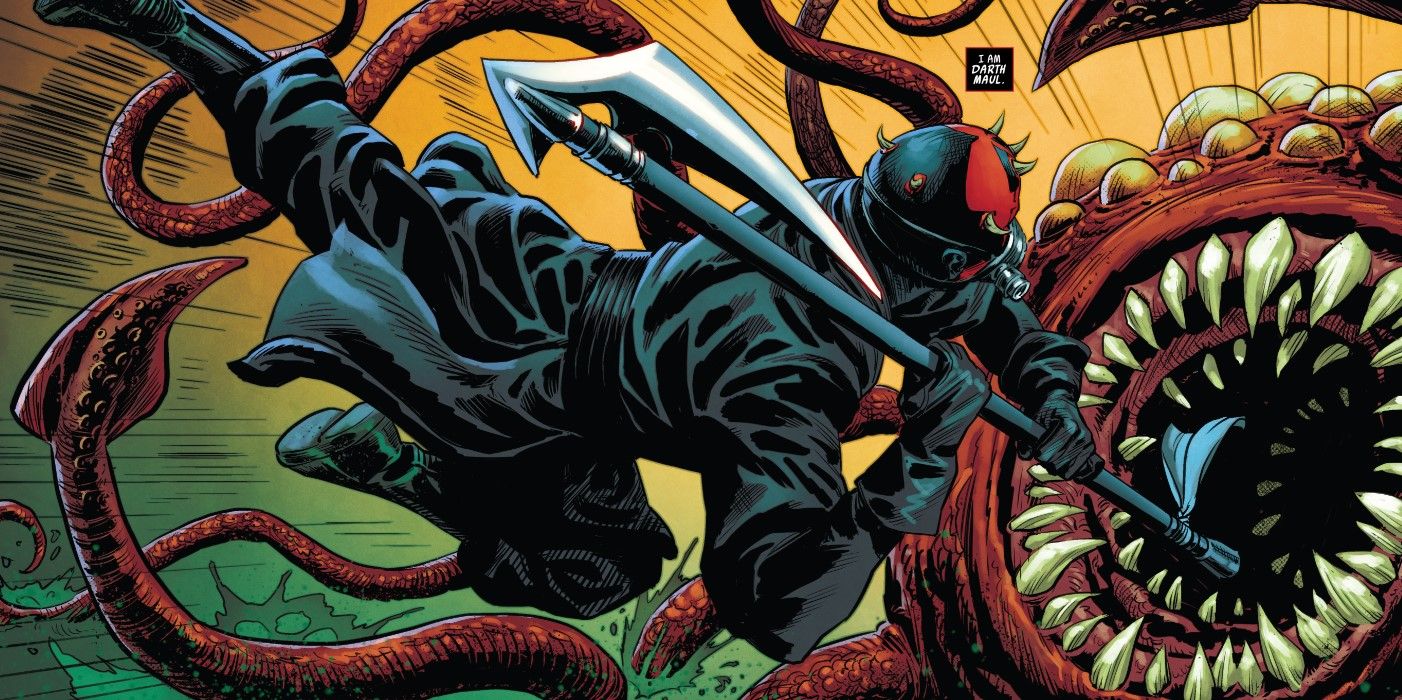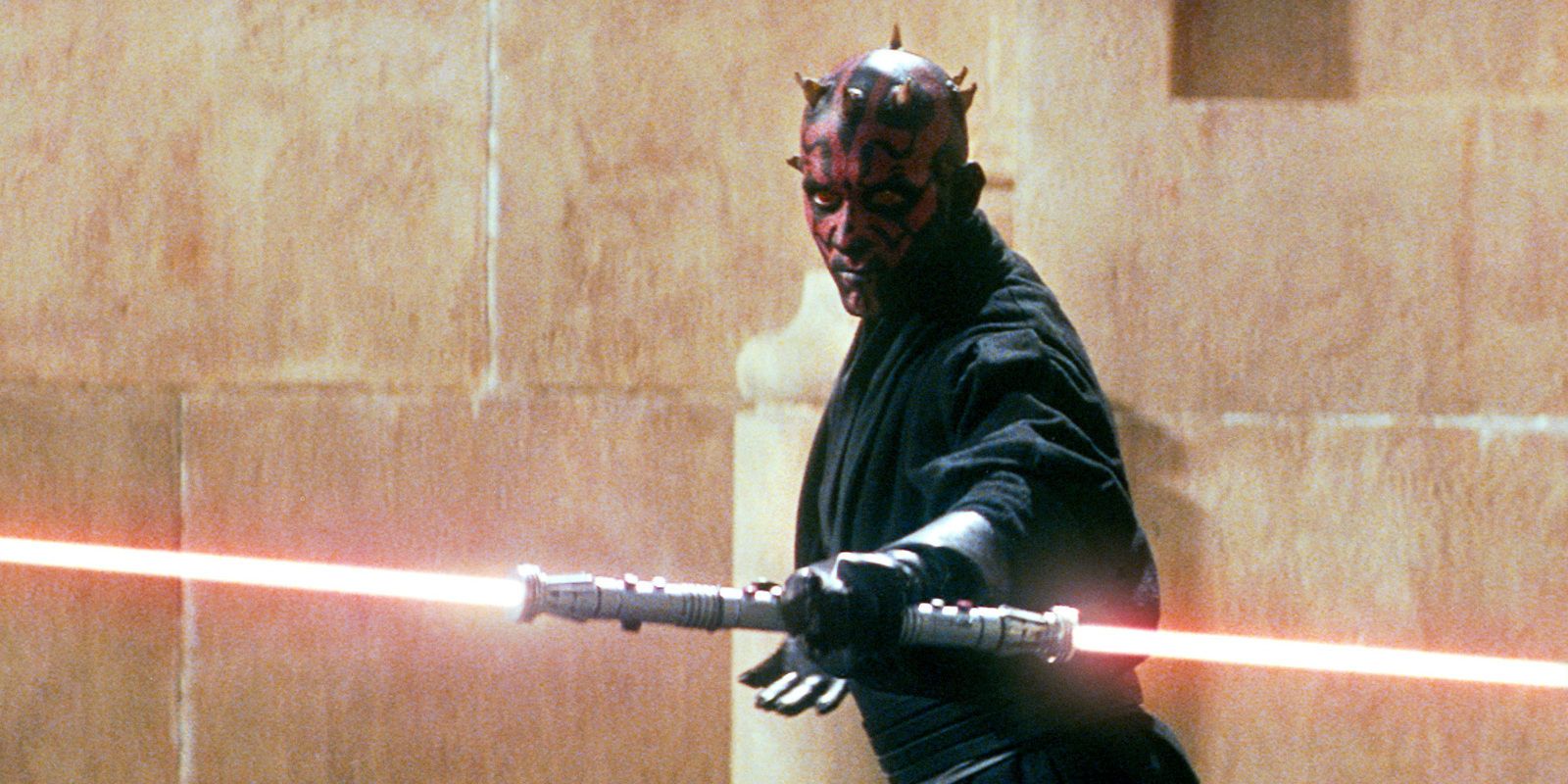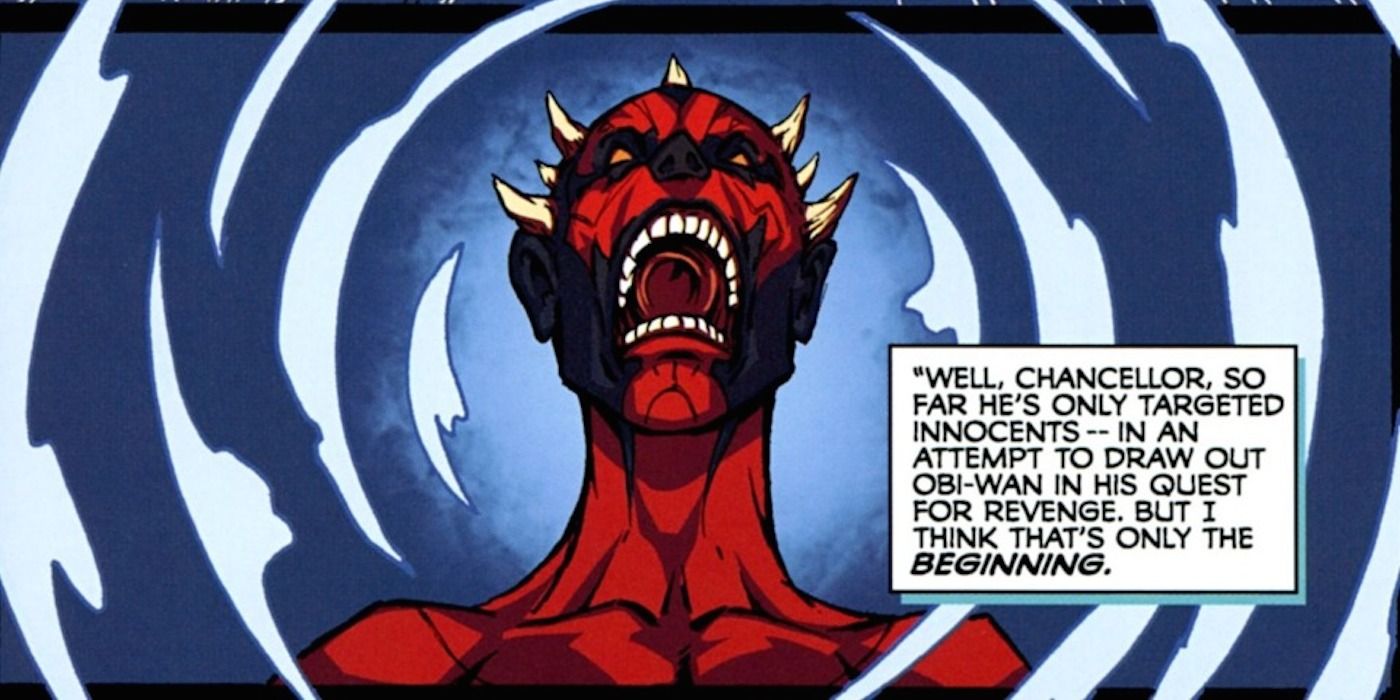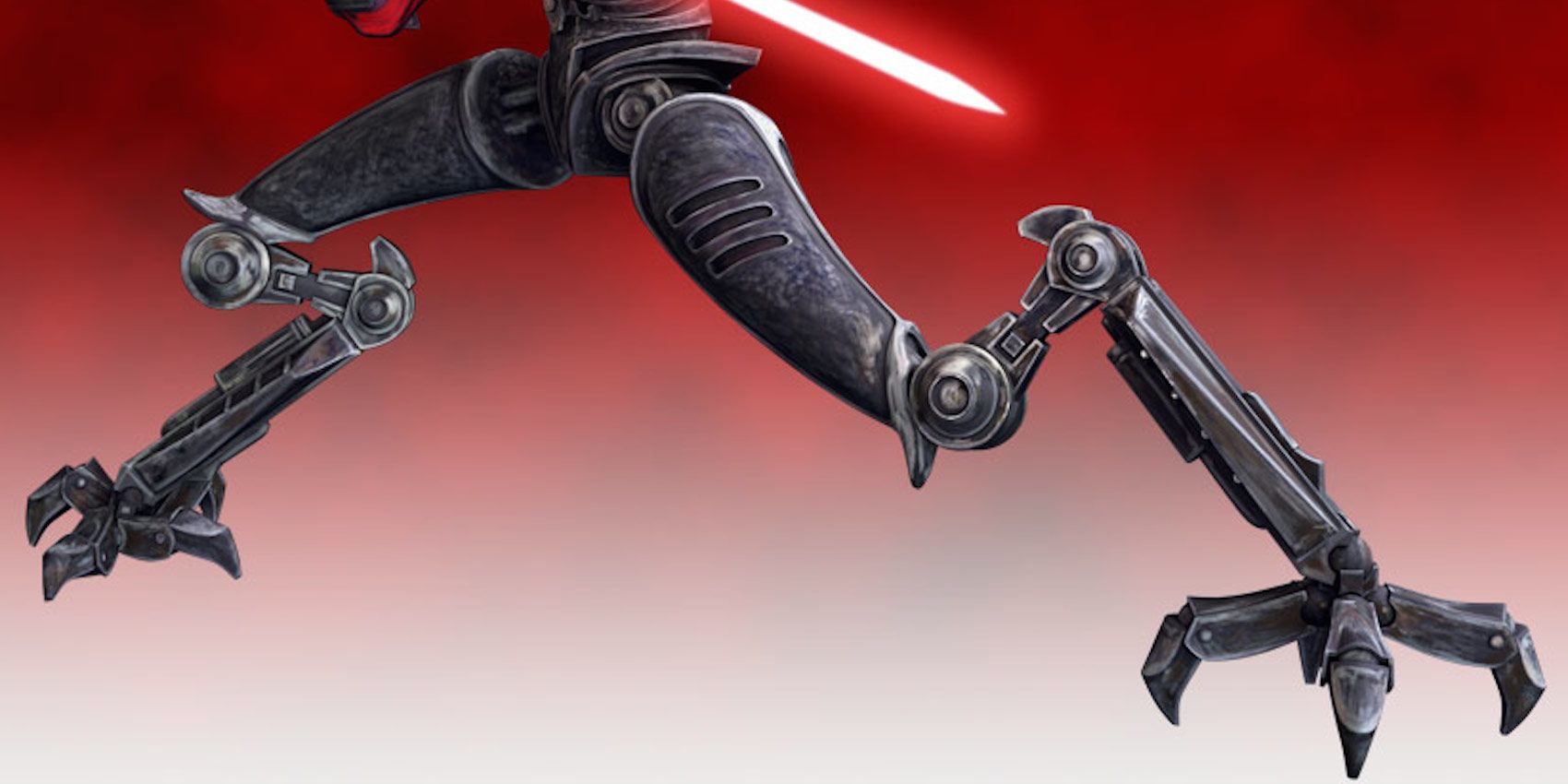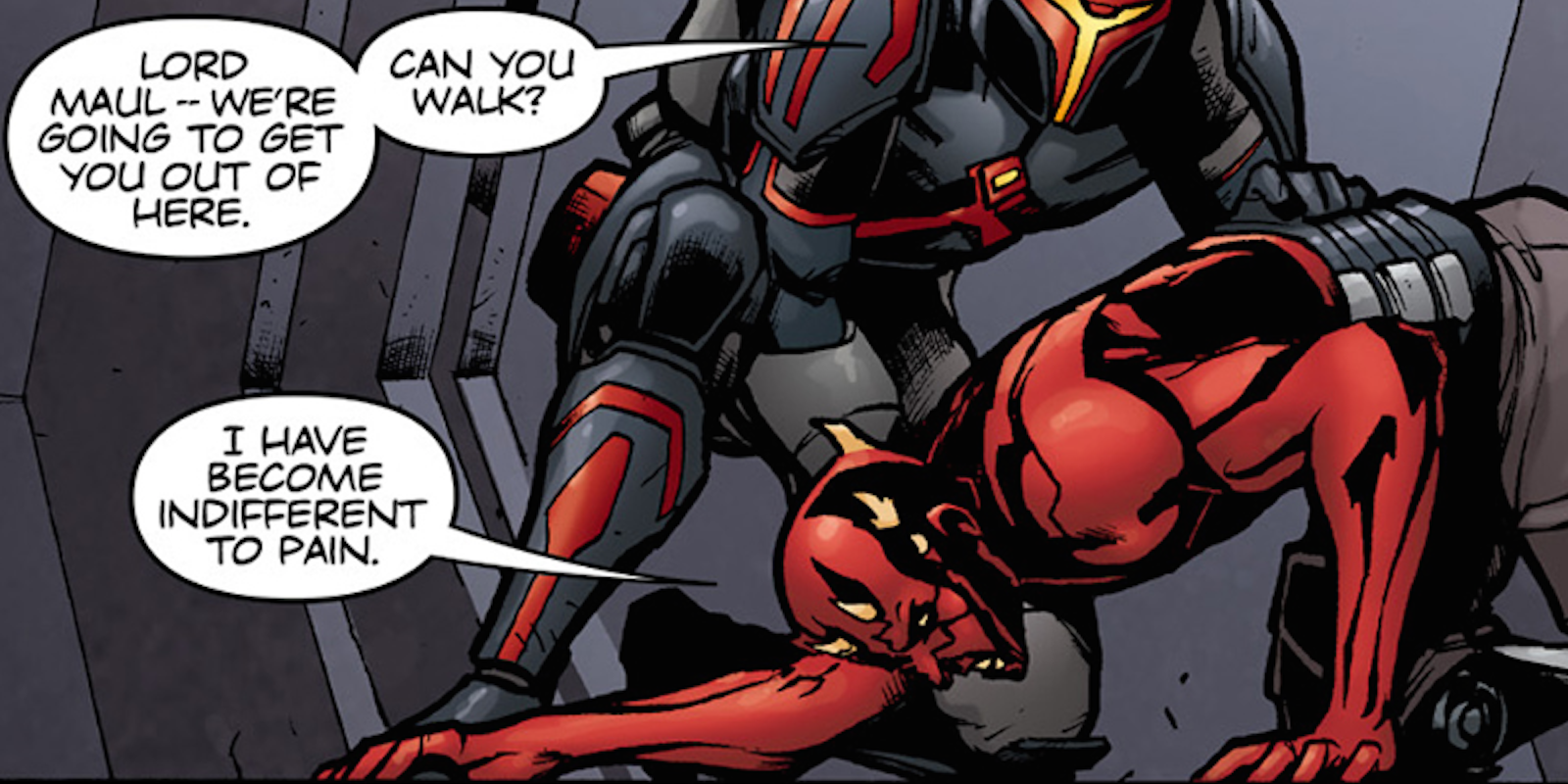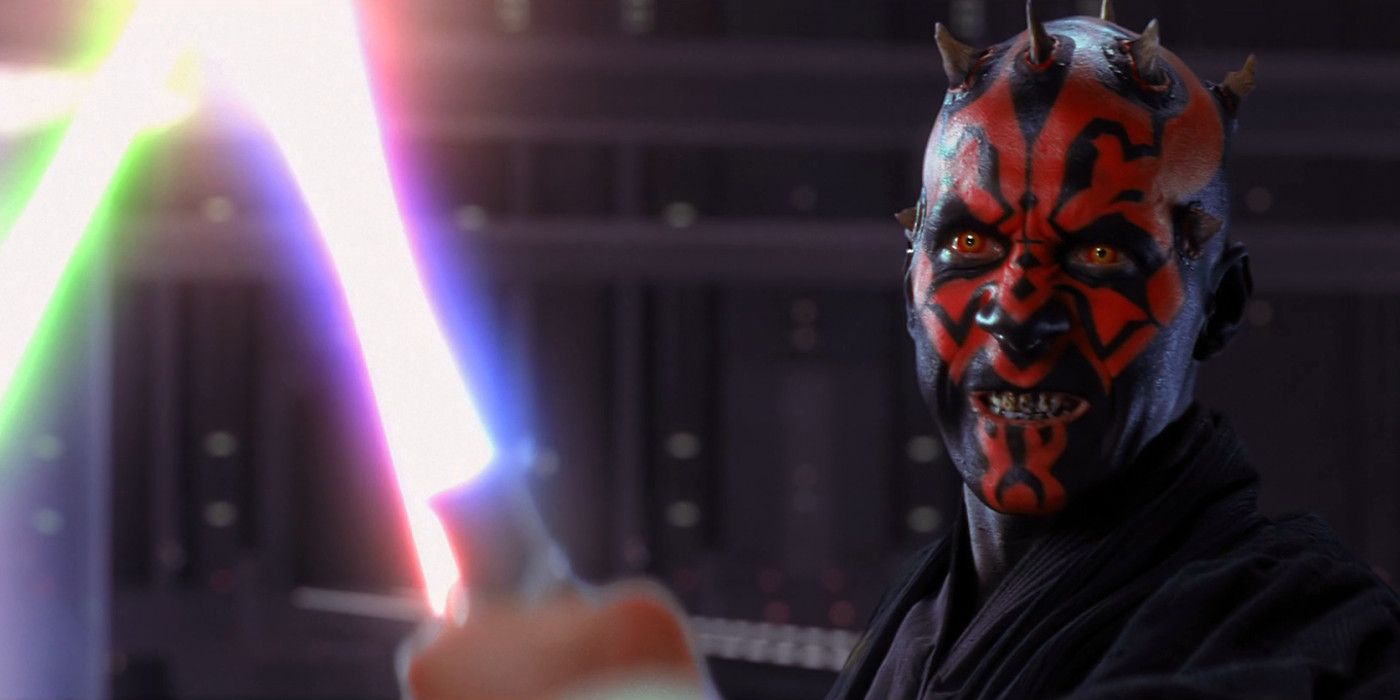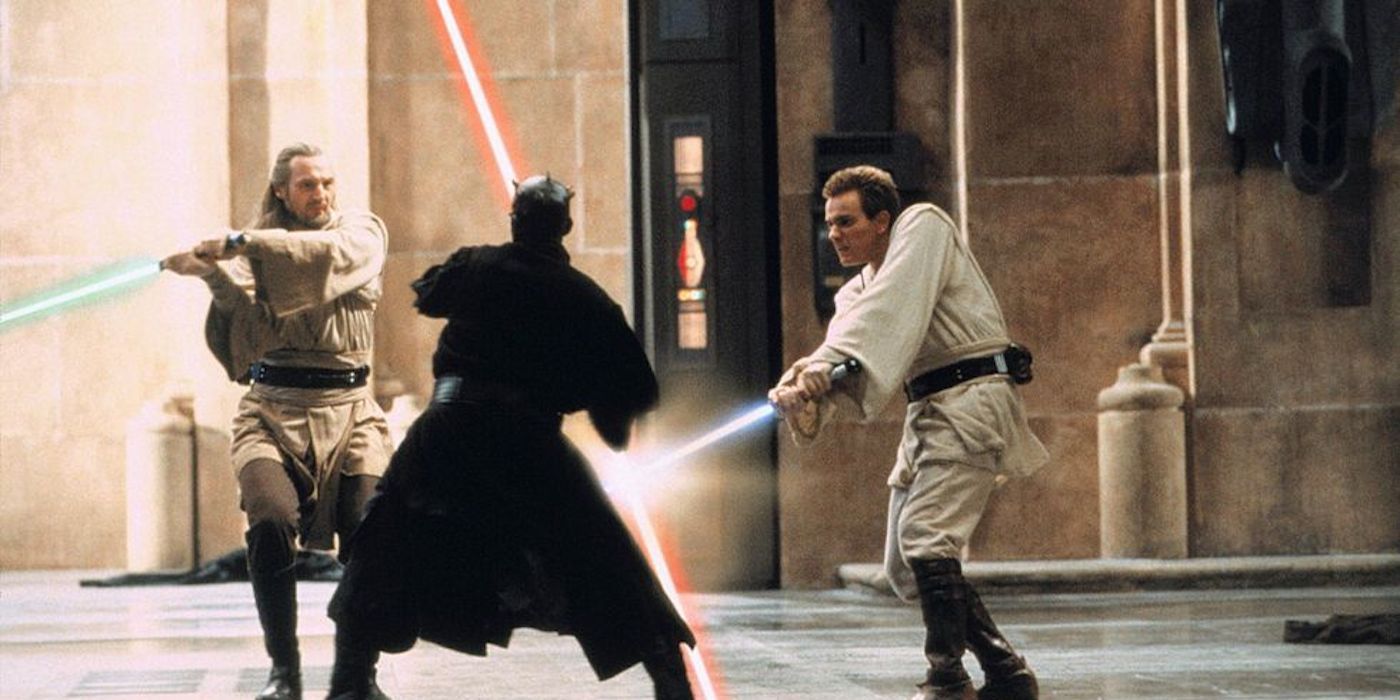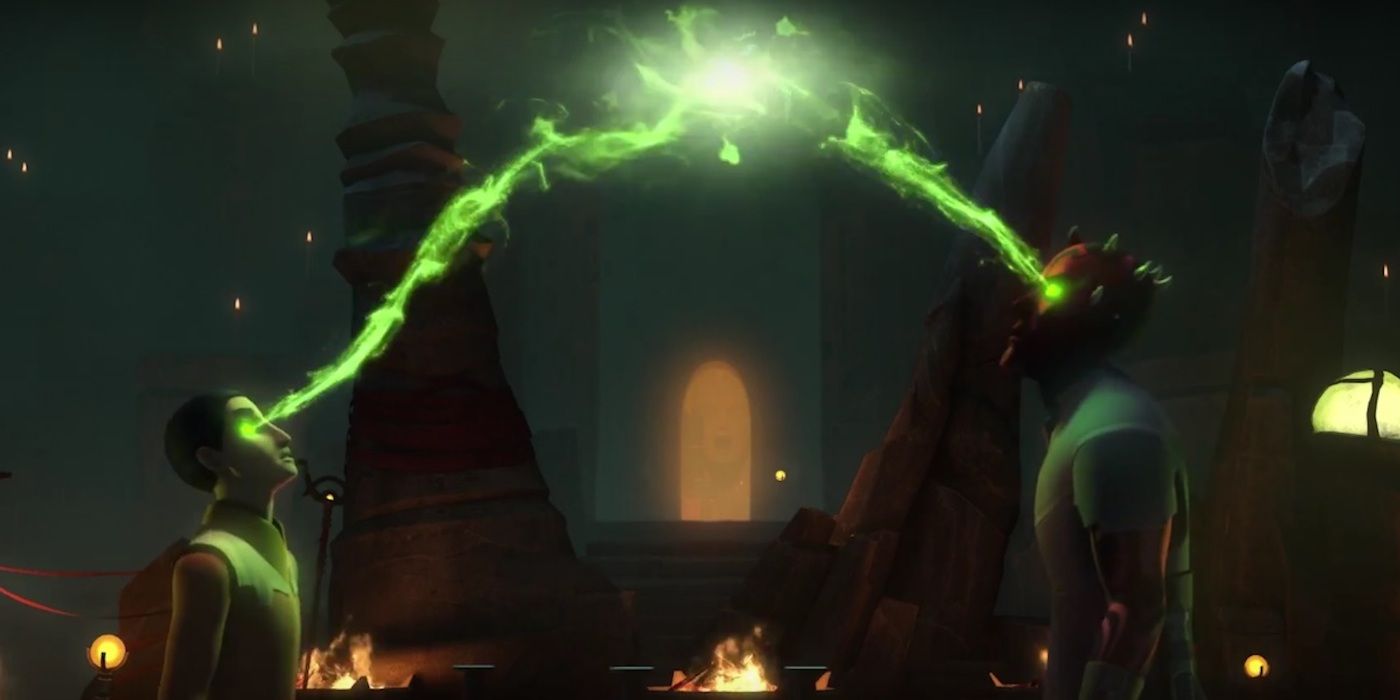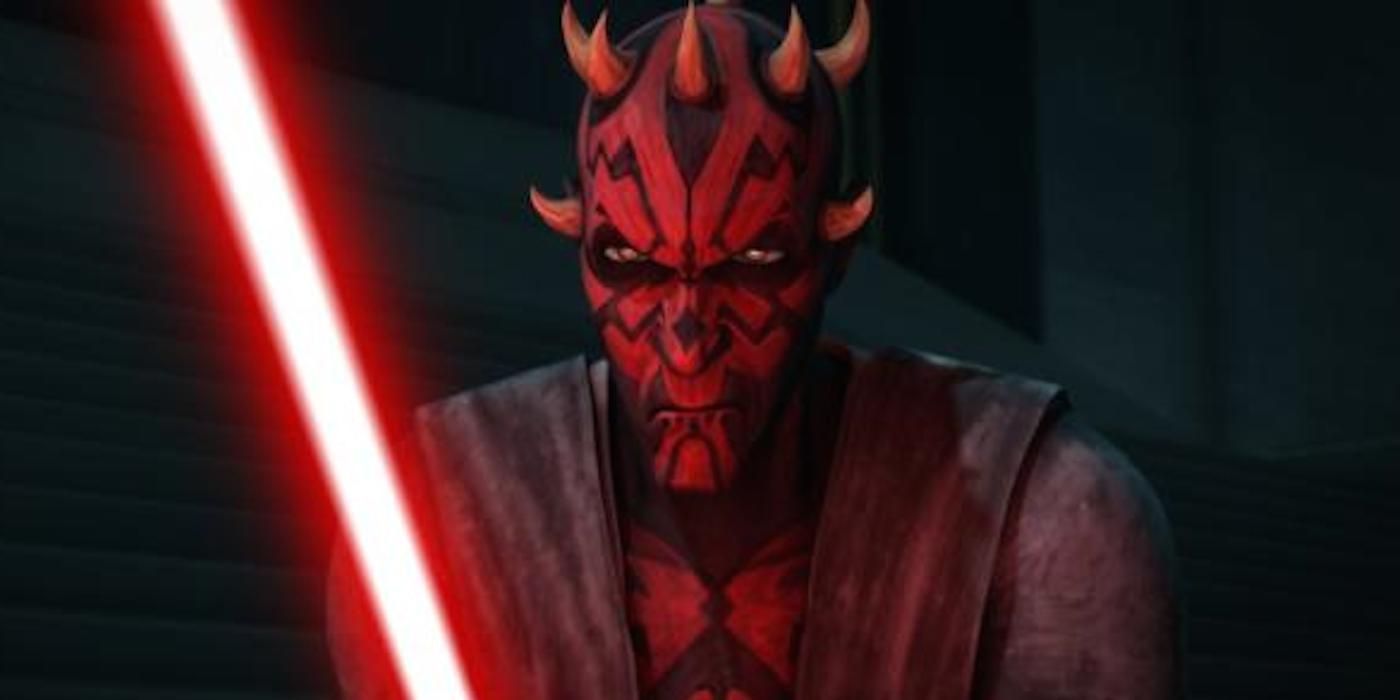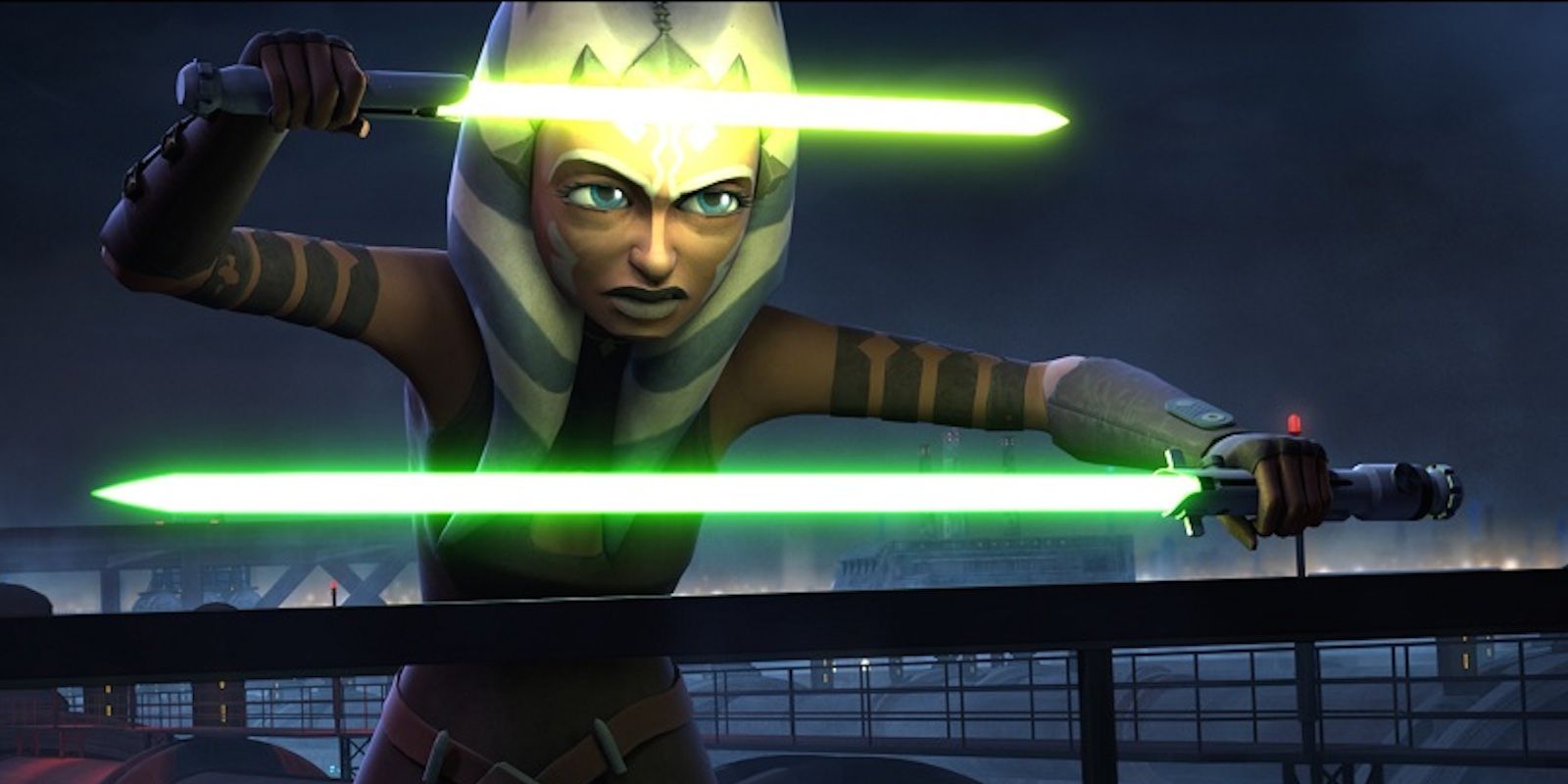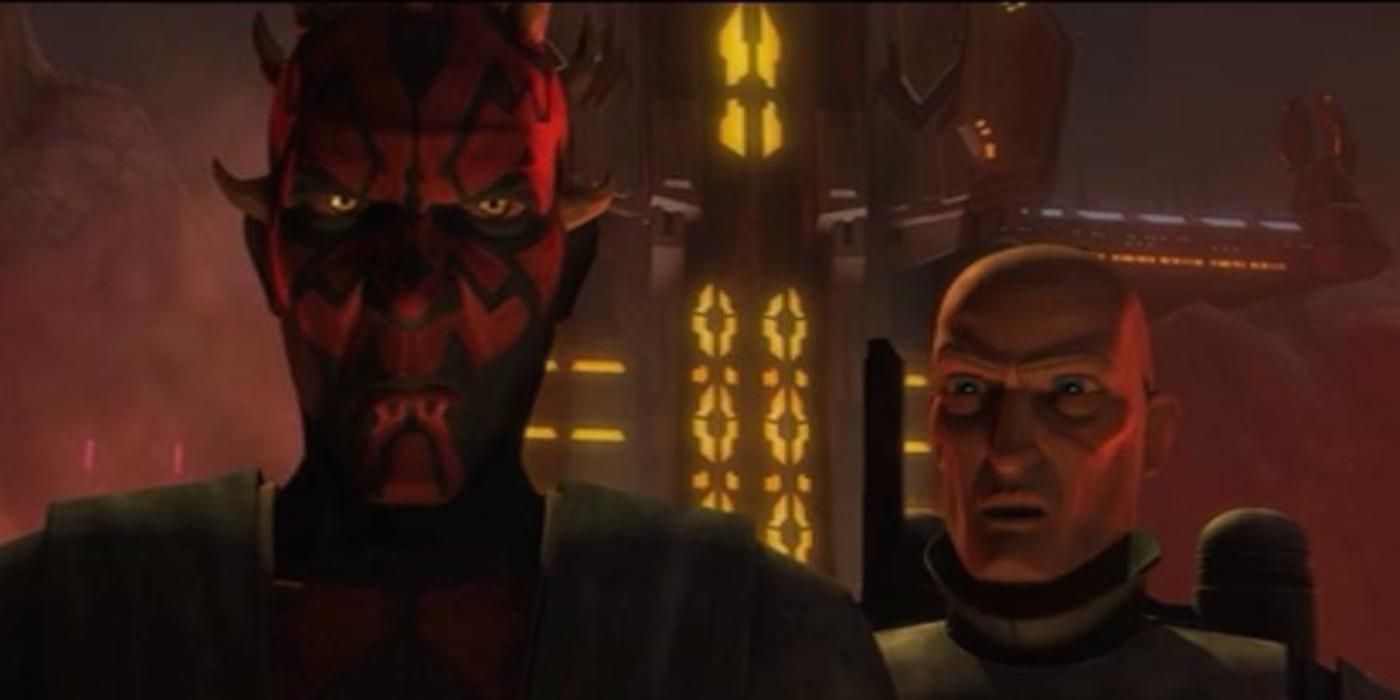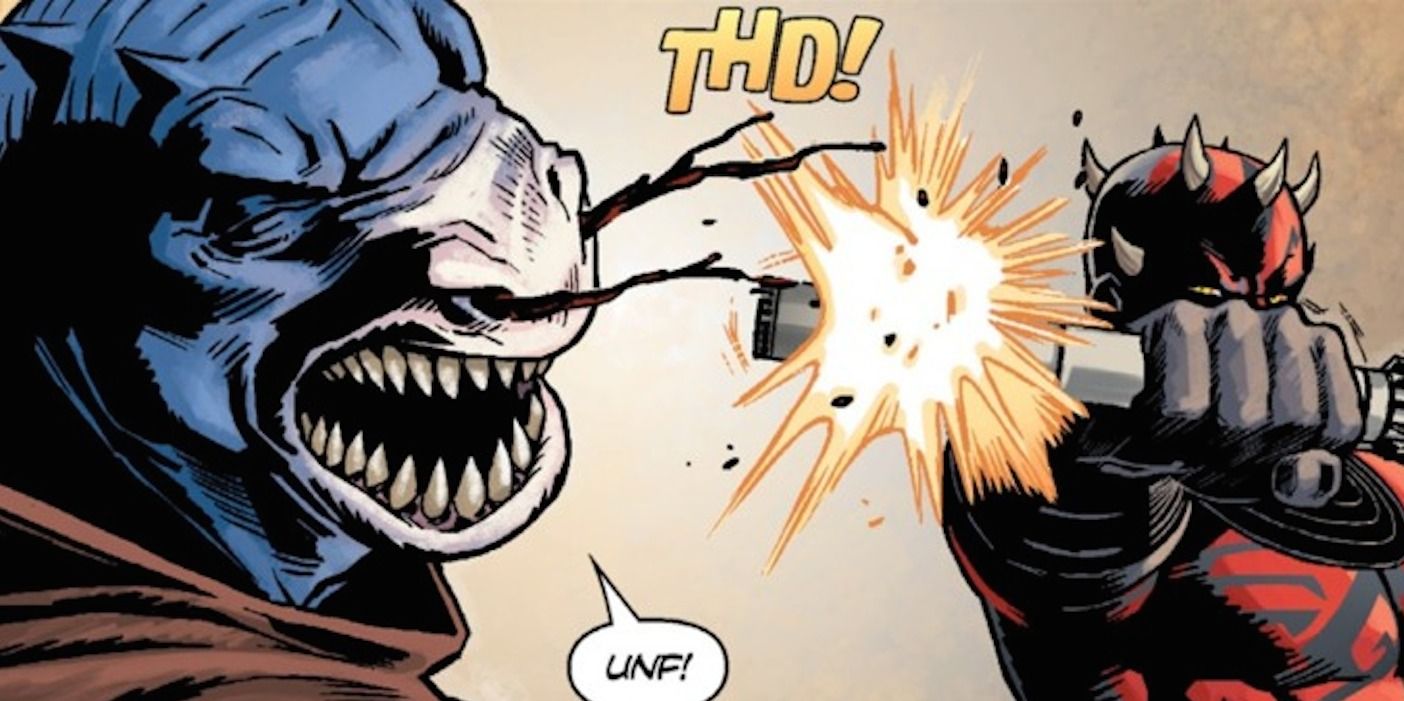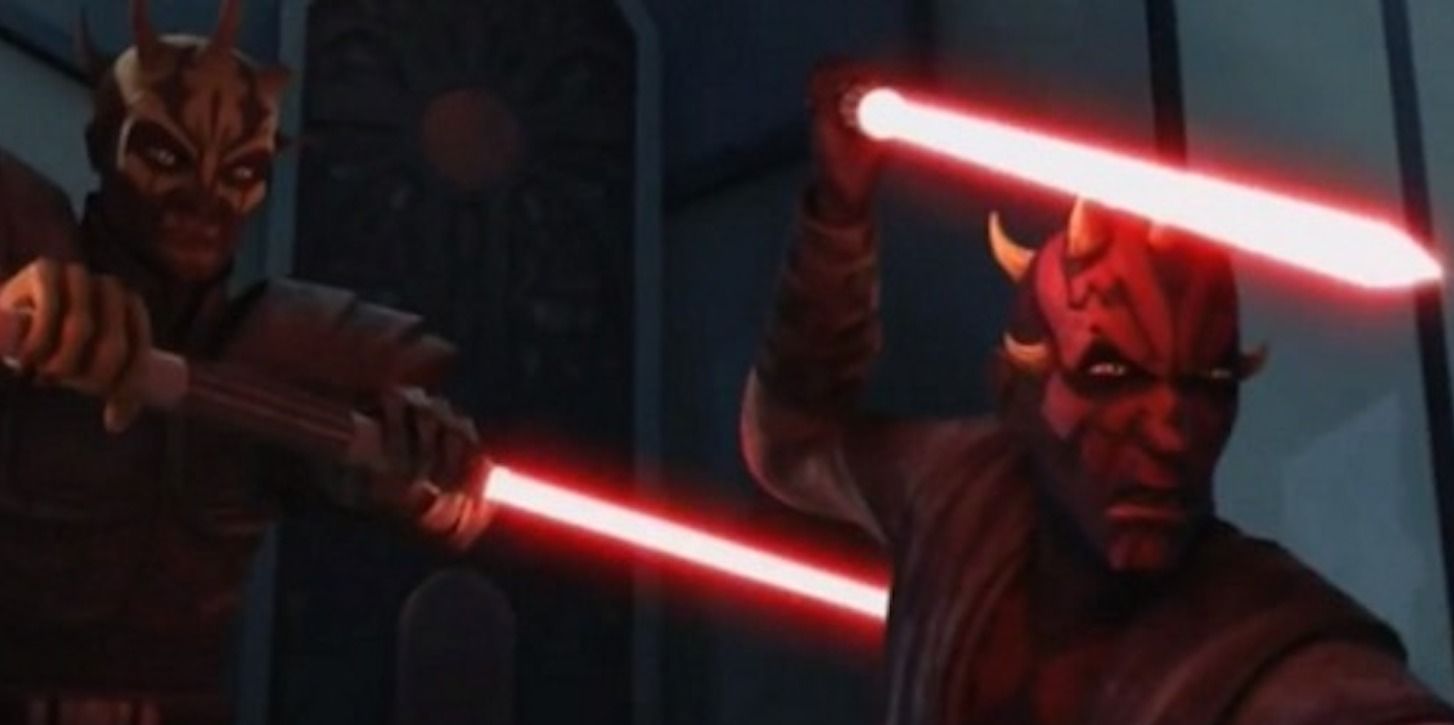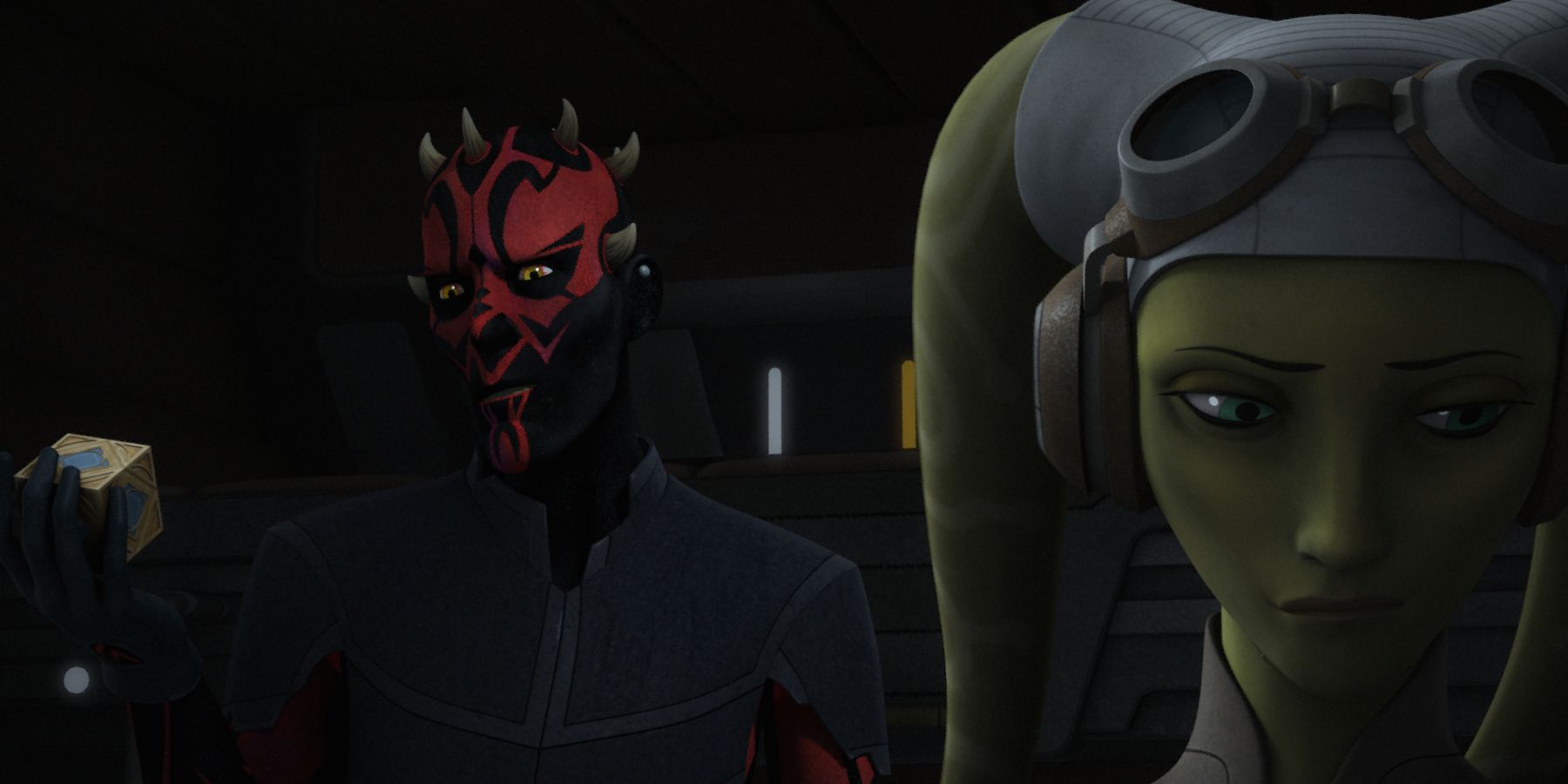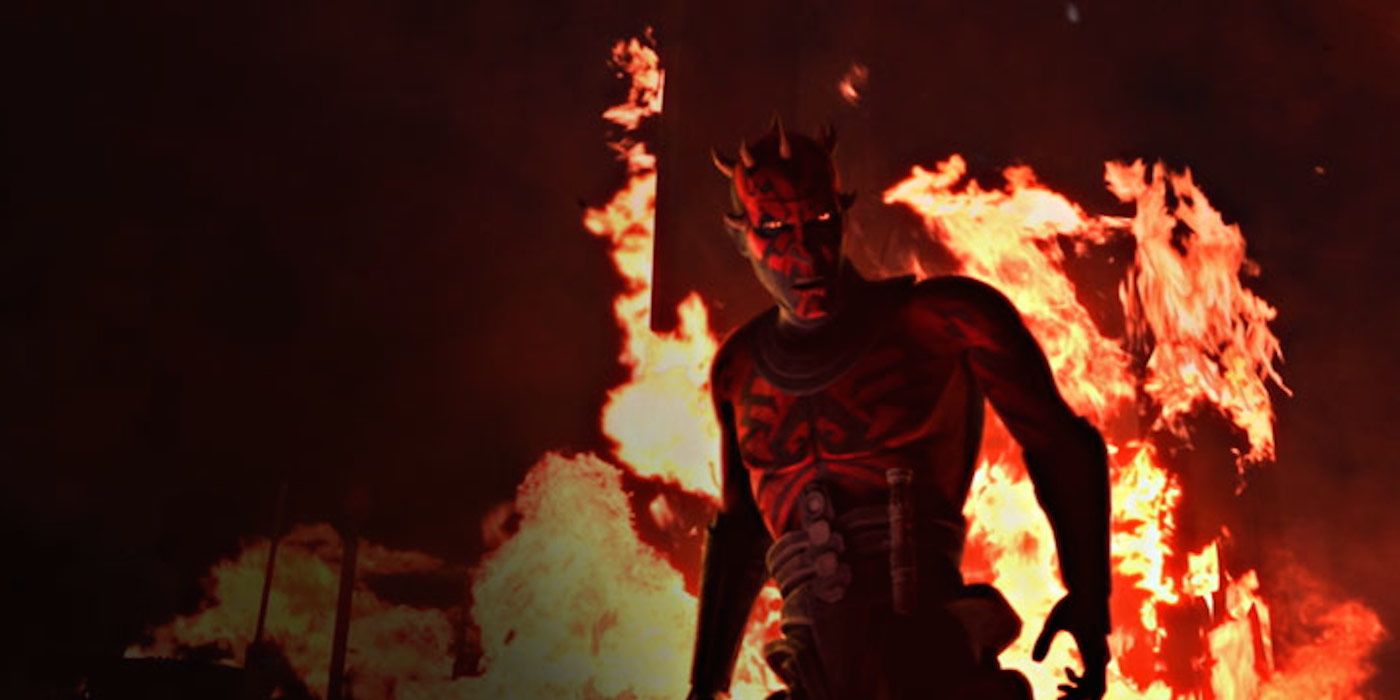At one point, picturing Darth Maul as a prevalent Star Wars character was a difficult thing to do. In fact, most casual Star Wars fans probably don't know that Maul is still alive. He survived the duel on Naboo and has since popped up numerous times throughout Star Wars lore, not just in the Legends but also in the new Canon. Having been featured multiple times on Star Wars: Rebels, Maul is perhaps the most blatantly prequel-related Star Wars entity to weasel its way into Lucasfilm's nostalgia-heavy run with Disney. So how has Maul, who started as a Halloween costume with a cool weapon, lasted this long?
Many factors could account for Maul's unexpected popularity. People realized there were rich story possibilities for Sidious' discarded apprentice. Voice actor Sam Witwer breathed furious life to the character on Star Wars: The Clone Wars and later on Rebels. And Maul's physical appearance in The Phantom Menace, though his only interesting quality at the time, remains the most iconic visual of the prequels. Whichever factor contributed most to Maul's success, even the harshest prequel haters have trouble admitting they don't look forward to seeing the Dathomirian show up once and a while.
To celebrate Maul's underdog story, we found 15 Powers You (Probably) Didn't Know Darth Maul Had.
15. Force Scream
A phenomenon reserved for those alined with the Dark Side, the Force Scream was an involuntary cry that influenced bystanders with energy waves of hatred. Although Force Scream was an unintentional power, only the strongest Force sensitive beings were able to do it. Maul was one of them.
Most famously (or infamously, for Star Wars fans), the Force Scream arose from Anakin Skywalker just after he transformed into Darth Vader. But long before that, Maul had a similar experience with Force Scream. After he become part machine, like Vader would in the future, Maul used Force Scream so loudly that the sound travelled across an entire canyon.
Not long after his reconstruction, Maul used Force Scream in battle against Obi-Wan Kenobi. Accompanied by his brother Savage Oppress, Maul fought Kenobi, who had temporarily allied with Asajj Ventress. As Obi-Wan and Ventress escaped, Maul let out a Force Scream in pursuit of them. It didn't do much then. But hey, he could still pull it off.
14. Cybernetic Legs
After nearly dying on Naboo, Maul managed to survive by fully succumbing to his hatred. But his dedication to living in hate came at the cost of his mental faculties. When his brother Savage Oppress found him on the trash planet of Lotho Minor a decade later, Maul was in a state of pure madness and had spider-like legs made from garbage.
When Oppress returned Maul to Dathomir, their home planet, Mother Talzin and The Nightsisters healed his body and mind, which meant giving him a more appropriate set of legs. Mother Talzin used magic to restore his sanity and give him cybernetic legs built from the broken parts of battle droids.
Maul used these new legs to his advantage in his quest to take revenge on Obi-Wan. The legs, on top of allowing him to walk comfortably again, had many benefits. They propelled Maul higher into the air whenever he jumped, enhanced his maneuverability in battle, and provided a stronger kick than Maul could have accomplished before. His metal feet took a toll on even the most powerful Jedi.
13. High Pain Tolerance
Maul could withstand a heavy amount of pain thanks to his Zabrak heritage. The Zabraks, a precursor to the Dathomirians, were a species of physiologically unique aliens with horns and two hearts. Maul's resistance to physical pain showed from an early age. He got his first tattoos, the black marks that would soon paint his entire body, before he was even one year old.
As he got older and trained under Darth Sidious, his invulnerability only increased. Under the Sith Lord's intense tutelage, Maul learned the ways of the Dark Side at a facility on Mustafar. Sidious reared Maul to be a vicious assassin, and made it so the Dathomirian could take as many hits as he could deliver.
Maul became so strong he could eventually sustain a Force Lighting attack, like the one he suffered from a powerful Nightsister. He reached his limits only when he received a Force Lighting strike from Darth Sidious, who was the only one powerful enough to hurt Maul with it.
12. Juyo
There were many lightsaber forms Maul had mastery over. One of them was Juyo, also known as The Ferocity Form. As its nickname would suggest, Juyo was regarded by practitioners from both sides of the Force as the most vicious lightsaber form. Its power was so great that the Jedi Order ended up restricting it. Meanwhile the Sith, Maul included, embraced it.
Aside from requiring a profound amount of fury, Juyo was regarded as the hardest form to master. To use it in battle meant summoning a remarkable amount of passion while remaining focused. If used correctly, it could be effective as an offensive method in a lightsaber duel.
Having the privilege of landing on the Dark Side of the Force, Maul had no reservations about acquiring the Juyo technique. Juyo eluded Jedi so much that Mace Windu, one of the Jedi Order's most powerful members, developed an adjusted version called Vapaad. But Maul stuck to pure, unadulterated Juyo.
11. Ataru
Another speciality Maul had in the realm of lightsabers was master of the Ataru form. Ataru was often referenced as the Way of the Hawk-Bat by Force users, and those who practiced it employed the Force to heighten their acrobatic ability. The Phantom Menace made it clear that Maul certainly has an aptitude for acrobatics, an indication that he favored Ataru.
Ataru, like Juyo, was a predominantly offensive battle tactic. A Jedi or Sith would have to execute large, quick, impactful swings in order to achieve it. Ataru provided a substantial workout for swordsmen, entailing plenty of jumps, spins, somersaults, and a healthy dosage of running. All were tasks Maul was more than ready to take on.
In one of his most impressive displays of Ataru, Maul used it heavily in his historic duel with Qui-Gon Jinn and Obi-Wan Kenobi. After facing Jinn once before on Tatooine, Maul intuited that Ataru would be the best technique to use against the Jedi Master. His suspicions proved correct when he later killed Jinn in the Theed Royal Palace on Naboo.
10. Mechu-deru
Combat aside, Maul had obtained a myriad of other skills over his lifetime. One of them was mechu-deru, a Force ability created and exclusively practiced by agents of the Dark Side. Mechu-deru bonded Sith masters to mechanical and robotic systems and allowed them to control machinery using the Force.
Like Juyo, mechu-deru was a regiment that Jedi evaded at all cost, limiting its use to a small group of Jedi tech specialists. And even among the Sith, mechu-deru was an outlier in the pantheon of their abilities, and from the time of its inception only a handful of Sith employed it.
But Maul, already gifted with technology, never hesitated to use the Force in conflation with mechanics. He was adept enough with mechu-deru to manipulate a protocol droid, turn it into an assassin droid, and program it to guard his ship while he was away. Essentially he turned a C3PO model into a killing machine.
9. Nighsister Magick
Maul descended from a long line of Dathomirian women known as the Nightsisters. His own mother, Mother Talzin, lead her own coven of Nightsisters in the art of magick. Magick was an supernatural energy, rich on Dathomir in particular, that could be used to draw power from the Dark Side of the Force. Belonging to neither the Jedi nor the Sith, the Nightsisters used magick for their own purposes.
By the time the Empire had conquered the galaxy, Maul was the last remaining survivor of the Nightsister clan. With the help of a Jedi in training named Ezra Bridger, Maul tapped into magick on Dathomir in an attempt to determine the new location of Obi-Wan Kenobi.
The ritual he engaged in with Ezra was risky, and Nightsister spirits presented themselves demanding a blood and flesh sacrifice in return for their information. Maul was able to break free from the spirits with the answers he needed: Obi-Wan was hiding out on some planet with twin suns.
8. Niman
Unlike the lightsaber forms previously mentioned, Niman was known for its moderation. One of its unofficial names was the Diplomat's Form. There were no huge advantages to Niman, but there were no major pitfalls either. A more leisurely type of bladework, Niman was preferred among those who preferred spending time studying instead of exercising blunt force.
Maul might have been more inclined to choose an abrasive lightsaber form, but he showed an aptitude for Niman. Darth Sidious was intent on including Niman as part of Maul's grueling training process. When the training was complete, Maul became a Niman practitioner.
This achievement might not seem like much, but it's worth noting that Obi-Wan, an otherwise talented adversary for Maul, had trouble pinning down Niman. The fact that Obi-Wan had these difficulties with a Jedi master like Qui-Gon Jinn guiding him is telling. Even Anakin Skywalker underestimated the pluses applying Niman during combat, which came at the cost of his arm in a fight with Count Dooku.
7. Jar'Kai
It's no mystery to even non-Star Wars fans that Maul could handle a double sided lightsaber. But fewer people might not be aware that he could also fight with two separate lightsabers at once, a fighting style called Jar-Kai. Jar-Kai was best known as the method of choice for Asajj Ventress and Anakin Skywalker's apprentice, Ahsoka Tano.
Jar-Kai has roots in Niman, which integrated dual blade swordsmanship. Similarly, those who studied Ataru became familiar with elements of Jar-Kai. The use of two lightsabers was tricky to accomplish. Ahsoka Tano gained the admiration from Jedi for accomplishing it as a padawan.
Duelists like Maul who were capable with Jar-Kai reaped the benefits that came with it. Namely, Jar-Kai allowed fighters to more easily fend off multiple opponents simultaneously. Two blades also increased the rate of attack significantly, and tended to overwhelm opponents defending themselves with a single blade. In case it's not clear yet, Maul is really really good with lightsabers.
6. Political Finesse
Maul was as politically savvy as he was physically gifted. A quality he likely inherited from his former Master (the eventual ruler of the galaxy), Maul could infiltrate any collective and swiftly rise in its ranks. Most notably, he overtook the Death Watch, a team of ruthless Mandelorian soldiers, and used them to serve his intentions (which, surprise surprise, involved revenge on Obi-Wan Kenobi).
Death Watch recruited Maul, planning to use him to their own ends and then betray him. Lording the possibility of Obi-Wan's suffering, Death Watch asked for Maul's assistance in taking dominion over Mandelore. Maul agreed to their offer, but saw through their deception and conceived plans of his own in secret.
After Death Watch reclaimed Mandelore, Maul entered a violent duel with the group's leader and beheaded him with the Darksaber, a sacred Mandelorian weapon. By doing so, Maul not only seized control over Death Watch, but also over all of Mandelore. As icing on the cake, during this ordeal Maul killed Duchess Satine, a high official on Mandelore and love interest to Obi-Wan Kenobi, right in front of his Obi-Wan's eyes.
5. Teräs Käsi
Teräs Käsi translated to Galactic Basic means "steel hand." This kind of fighting stressed unarmed combat, and did not include any weaponry. Teräs Käsi fight moves were traditionally named after creatures from all over the galaxy, like the Charging Wampa or Rancor Rising.
Non-Force Sensitive beings first developed Teräs Käsi on a planet called Bunduki, and was later adopted by Force users with impressive results. Maul was prone to using Teräs Käsi in conjunction with his lightsaber techniques. Teräs Käsi proved effective in the hands of a Non-Force wielder, it's power increased substantially when harnessed by somebody like Maul.
Beyond the effectiveness it yielded in an offensive, Teräs Käsi was helpful to Maul because it gave insight for how to fight those trying to resist the Force. Teräs Käsi offered users skills needed to block Force users from their minds, protecting them against mental attacks. So if someone like Maul could understand Teräs Käsi, he could find ways to dismantle a non-Force sensitive's defenses.
4. Battlemind
Jedi used Battlemind to bolster their spirit in the midst of combat. Battlemind, aided by the Force, imbued fighters with the motivation they needed to persevere during battle. Since it came with potential hazard of fighting with increased passion, most orthodox Jedi avoided it. But Maul, like with many techniques marked taboo by Jedi, was willing to indulge Battlemind when he could.
Since Battlemind could pull users closer to the Dark Side of the Force, it was not recommended to those who doubted their resistance to such powers. Maul, on the other hand, was already deeply entrenched in the Dark Side, and was thus unconcerned with delving into it further.
Battlemind was not only spiritual in it's positive effects, but also could enhance a person's physical capabilities. Maul could use it alongside Force rage to intensify his already daunting status as a warrior. All of his skills, lightsaber forms especially, could be amplified with Battlemind.
3. Lanvarok Wielder
A weapon of brute strength, the lanvarok was so deadly that even Darth Sidious was wary of it. The Sith Lord described it as messy and imprecise, something capable of raining down terror onto its victims. Created by and for Sith, the lanvarok was really an amalgamation of two weapons, namely a double handed polearm that could launch projectiles infused with poisons. In Maul's hands, the lanvarok could commit unspeakable damage.
On an offensive front, the lanvarvok had a reach of 15 meters in polearm form and up to 90 meters in its forearm-mounted model. Its height was always at least on par with its user, sometimes even higher. Lanvaroks didn't want for defensive features, considering they sported an alloy impervious to lightsabers.
As evidenced by his penchant Teräs Käsi , Maul was never limited to a lightsaber when it came to battle. But his competence with a lanvarok proved there were other weapons he could use against his enemies, weapons that could hurt anyone worst than a lightsaber ever could.
2. Force Sight
In the way Battlemind could assist a user's physical abilities, Force Sight could do wonders for one's senses. As a highly revered skill, Force Sight was taught long after the fall of the Jedi order when Obi-Wan imparted the concept onto Luke Skywalker. The importance of this Force tool was not lost on Obi-Wan, nor was it lost on Maul.
Those who solicited Force Sight were rewarded with improved visual and spacial awareness, even in dark environments. Their natural sight being largely unreliable, Jedi and Sith could depend on Force Sight as a defense mechanism. The ability could deflect attacks like Force persuasion and Force blinding.
Maul's proficiency with Force Sight once again exemplified his respect for defensive measures. While outwardly he came off as a predominantly physical combatant, he no doubt kept his defense mechanisms refined in the likely event that he needed them.
1. Dun Möch
Dun Möch was a taunting mechanism put to use during lightsaber duels. A practitioner would laud jeers or insults onto his opponent with the end goal of catching him off-guard. Dun Möch, another Sith favored tactic, would dig deep into a person's inner weakness to undermine them psychologically. In essence, this was a Sith's way of fighting dirty.
In his early days, Maul withheld the application of Dun Möch, wanting instead to best opponents relying mainly on his physical prowess. But after his defeat at the hands of Obi-Wan on Naboo, and subsequent years accumulating hate for Obi-Wan, Maul started to acknowledge Dun Möch as a viable option in a fight. With his loathsome attitude towards his nemesis, Maul would have no shortage of artillery when it came to using Dun Möch against Kenobi.
Ultimately Maul did use Dun Möch in his fight with Obi-Wan and Asajj Ventress on the planet Raydonia. Even before Maul and Obi-Wan locked blades, Maul sent Obi-Wan holographic images of him killing Raydonian villagers to lure him into battle. By doing so, achieved a sort of pre-Dun Möch, tearing into Kenobi's doubt even before the two were on the same planet.
Maul can be seen on Star Wars: Rebels, which airs Saturday at 8:30/7:30c on Disney XD.

